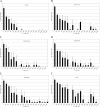Systematic evaluation of the efficacy of chlorine dioxide in decontamination of building interior surfaces contaminated with anthrax spores
- PMID: 20305025
- PMCID: PMC2869126
- DOI: 10.1128/AEM.02668-09
Systematic evaluation of the efficacy of chlorine dioxide in decontamination of building interior surfaces contaminated with anthrax spores
Abstract
Efficacy of chlorine dioxide (CD) gas generated by two distinct generation systems, Sabre (wet system with gas generated in water) and ClorDiSys (dry system with gas generated in air), was evaluated for inactivation of Bacillus anthracis spores on six building interior surfaces. The six building materials included carpet, acoustic ceiling tile, unpainted cinder block, painted I-beam steel, painted wallboard, and unpainted pinewood. There was no statistically significant difference in the data due to the CD generation technology at a 95% confidence level. Note that a common method of CD gas measurement was used for both wet and dry CD generation types. Doses generated by combinations of different concentrations of CD gas (500, 1,000, 1,500, or 3,000 parts per million of volume [ppmv]) and exposure times (ranging between 0.5 and 12 h) were used to evaluate the relative role of fumigant exposure period and total dose in the decontamination of building surfaces. The results showed that the time required to achieve at least a 6-log reduction in viable spores is clearly a function of the material type on which the spores are inoculated. The wood and cinder block coupons required a longer exposure time to achieve a 6-log reduction. The only material showing a clear statistical difference in rate of decay of viable spores as a function of concentration was cinder block. For all other materials, the profile of spore kill (i.e., change in number of viable spores with exposure time) was not dependent upon fumigant concentration (500 to 3,000 ppmv). The CD dose required for complete spore kill on biological indicators (typically, 1E6 spores of Bacillus atrophaeus on stainless steel) was significantly less than that required for decontamination of most of the building materials tested.
Figures




Similar articles
-
Review of Decontamination Techniques for the Inactivation of Bacillus anthracis and Other Spore-Forming Bacteria Associated with Building or Outdoor Materials.Environ Sci Technol. 2019 Apr 16;53(8):4045-4062. doi: 10.1021/acs.est.8b05274. Epub 2019 Apr 2. Environ Sci Technol. 2019. PMID: 30901213 Free PMC article. Review.
-
Review of techniques for the in-situ sterilization of soil contaminated with Bacillus anthracis spores or other pathogens.Res Microbiol. 2024 May-Jun;175(4):104175. doi: 10.1016/j.resmic.2023.104175. Epub 2023 Dec 21. Res Microbiol. 2024. PMID: 38141796 Free PMC article. Review.
-
Quantitative method to determine sporicidal decontamination of building surfaces by gaseous fumigants, and issues related to laboratory-scale studies.Appl Environ Microbiol. 2009 Jun;75(11):3688-94. doi: 10.1128/AEM.02592-08. Epub 2009 Apr 3. Appl Environ Microbiol. 2009. PMID: 19346341 Free PMC article.
-
Decontamination of Bacillus subtilis var. niger spores on selected surfaces by chlorine dioxide gas.J Zhejiang Univ Sci B. 2012 Apr;13(4):254-60. doi: 10.1631/jzus.B1100289. J Zhejiang Univ Sci B. 2012. PMID: 22467366 Free PMC article.
-
Decontamination of a hospital room using gaseous chlorine dioxide: Bacillus anthracis, Francisella tularensis, and Yersinia pestis.J Occup Environ Hyg. 2013;10(10):533-9. doi: 10.1080/15459624.2013.818241. J Occup Environ Hyg. 2013. PMID: 23971883
Cited by
-
Six-month low level chlorine dioxide gas inhalation toxicity study with two-week recovery period in rats.J Occup Med Toxicol. 2012 Feb 21;7:2. doi: 10.1186/1745-6673-7-2. J Occup Med Toxicol. 2012. PMID: 22348507 Free PMC article.
-
Review of Decontamination Techniques for the Inactivation of Bacillus anthracis and Other Spore-Forming Bacteria Associated with Building or Outdoor Materials.Environ Sci Technol. 2019 Apr 16;53(8):4045-4062. doi: 10.1021/acs.est.8b05274. Epub 2019 Apr 2. Environ Sci Technol. 2019. PMID: 30901213 Free PMC article. Review.
-
Review of techniques for the in-situ sterilization of soil contaminated with Bacillus anthracis spores or other pathogens.Res Microbiol. 2024 May-Jun;175(4):104175. doi: 10.1016/j.resmic.2023.104175. Epub 2023 Dec 21. Res Microbiol. 2024. PMID: 38141796 Free PMC article. Review.
-
Sterilization of hydrogen peroxide resistant bacterial spores with stabilized chlorine dioxide.AMB Express. 2015 Apr 17;5:24. doi: 10.1186/s13568-015-0109-4. eCollection 2015. AMB Express. 2015. PMID: 25897406 Free PMC article.
-
Evaluation of the Efficacy of Methyl Bromide in the Decontamination of Building and Interior Materials Contaminated with Bacillus anthracis Spores.Appl Environ Microbiol. 2016 Jan 22;82(7):2003-2011. doi: 10.1128/AEM.03445-15. Appl Environ Microbiol. 2016. PMID: 26801580 Free PMC article.
References
-
- Aieta, E. M., P. V. Roberts, and M. Hernandez. 1984. Determination of chlorine dioxide, chlorine, chlorite, and chlorate in water. J. Am. Water Works Assoc. 76:64-70.
-
- Bartram, P. W., J. T. Lynn, L. P. Reif, M. D. Brickhouse, T. A. Lalain, S. Ryan, B. Martin, and D. Stark. 2008. Material demand studies: interaction of chlorine dioxide gas with building materials EPA/600/R-08/091. U.S. Environmental Protection Agency, Washington, DC. http://www.epa.gov/NHSRC/pubs/600r08091.pdf.
-
- Beuchat, L. R., C. A. Pettigrew, M. E. Tremblay, B. J. Roselle, and A. J. Scouten. 2004. Lethality of chlorine, chlorine dioxide, and a commercial fruit and vegetable sanitizer to vegetative cells and spores of Bacillus cereus and spores of Bacillus thuringiensis. J. Food Prot. 67:1702-1708. - PubMed
-
- Canter, D. A. 2005. Remediating anthrax-contaminated sites: learning from the past to protect the future. Chem. Health Safety 12:13-19.
-
- Canter, D. A., D. Gunning, P. Rodgers, L. O'Connor, C. Traunero, and C. J. Kempter. 2005. Remediation of Bacillus anthracis contamination in the U.S. Department of Justice mail facility. Biosecur. Bioterror. 3:119-127. - PubMed
Publication types
MeSH terms
Substances
LinkOut - more resources
Full Text Sources
Other Literature Sources

